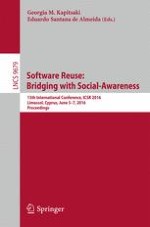This book constitutes the refereed proceedings of the 15th International Conference on Software Reuse, ICSR 2016, held in Limassol, Cyprus, in June 2016.
The 21 revised full papers presented together with 4 revised short papers were carefully reviewed and selected from 51 submissions. The papers cover different areas of software engineering, where software reuse plays an important role, such as software product lines, domain analysis and modeling, software tools and business aspects of software. ICSR 2016 has provided a complete view on the advancements in the area of software reuse in the last years for interested researchers and practitioners.
